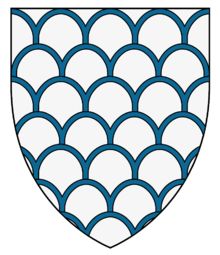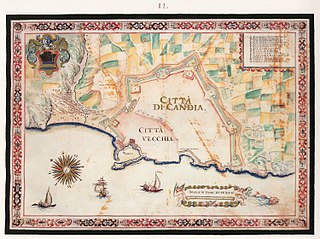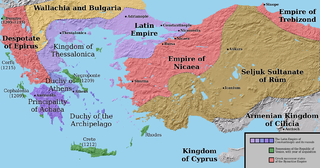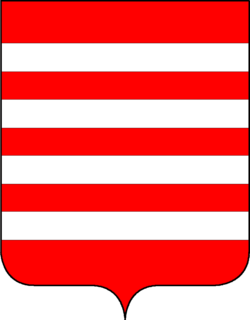Related Research Articles

Albert the Magnanimous KG, elected King of the Romans as Albert II was king of the Holy Roman Empire and a member of the House of Habsburg. By inheritance he became Albert V, Duke of Austria. Through his wife he also became King of Hungary, Croatia, Bohemia, and inherited a claim to the Duchy of Luxembourg.

The Duchy of Athens was one of the Crusader states set up in Greece after the conquest of the Byzantine Empire during the Fourth Crusade as part of the process known as Frankokratia, encompassing the regions of Attica and Boeotia, and surviving until its conquest by the Ottoman Empire in the 15th century.

The Duchy of the Archipelago, also known as Duchy of Naxos or Duchy of the Aegean, was a maritime state created by Venetian interests in the Cyclades archipelago in the Aegean Sea, in the aftermath of the Fourth Crusade, centered on the islands of Naxos and Paros. It included all the Cyclades. In 1537 it became a tributary of the Ottoman Empire, and was annexed by the Ottomans in 1579; however, Christian rule survived in islands such as Siphnos and Tinos.

William of Villehardouin was the fourth prince of Achaea in Frankish Greece from 1246 to 1278. The younger son of Prince Geoffrey I, he held the Barony of Kalamata in fief during the reign of his elder brother Geoffrey II. William ruled Achaea as regent for his brother during Geoffrey's military campaigns against the Greeks of Nicaea, who were the principal enemies of his overlord, the Latin Emperor of Constantinople Baldwin II. William succeeded his childless brother in the summer of 1246. Conflicts between Nicaea and Epirus enabled him to complete the conquest of the Morea in about three years. He captured Monemvasia and built three new fortresses, forcing two previously autonomous tribes, the Tzakones and Melingoi into submission. He participated in the unsuccessful Egyptian crusade of Louis IX of France, who rewarded him with the right to issue currency in the style of French royal coins.

Gattilusio was a powerful Genoese family who controlled a number of possessions in the northern Aegean from 1355 until the mid 15th century. Anthony Luttrell has pointed out that this family had developed close connections to the Byzantine ruling house of the Palaiologos—"four successive generations of Gattilusio married into the Palaiologos family, two to emperors' daughters, one to an emperor, and one to a despot who later became an emperor"—which could explain their repeated involvement in Byzantine affairs. The Gattilusi were Lords of Lesbos from 1355 to 1462 and Lords of Aenus from 1376 to 1456.
Carlo I Tocco was the hereditary Count palatine of Cephalonia and Zakynthos from 1376, and ruled as the Despot of Epirus from 1411 until his death on July 4, 1429.

Othon de la Roche, also Otho de la Roche, was a Burgundian nobleman of the De la Roche family from La Roche-sur-l'Ognon. He joined the Fourth Crusade and became the first Frankish Lord of Athens in 1204. In addition to Athens, he acquired Thebes by around 1211.

The siege of Thessalonica between 1422 and 1430 saw the Ottoman Empire under Sultan Murad II capture the city of Thessalonica, which remained in Ottoman hands for the next five centuries, until it became part of the Kingdom of Greece in 1912.

The Cretan War, also known as the War of Candia or the Fifth Ottoman–Venetian War, was a conflict between the Republic of Venice and her allies against the Ottoman Empire and the Barbary States, because it was largely fought over the island of Crete, Venice's largest and richest overseas possession. The war lasted from 1645 to 1669 and was fought in Crete, especially in the city of Candia, and in numerous naval engagements and raids around the Aegean Sea, with Dalmatia providing a secondary theater of operations.

The Frankokratia, also known as Latinokratia and, for the Venetian domains, Venetokratia or Enetokratia, was the period in Greek history after the Fourth Crusade (1204), when a number of primarily French and Italian states were established by the Partitio terrarum imperii Romaniae on the territory of the dissolved Byzantine Empire.

The First Ottoman–Venetian War was fought between the Republic of Venice and her allies and the Ottoman Empire from 1463 to 1479. Fought shortly after the capture of Constantinople and the remnants of the Byzantine Empire by the Ottomans, it resulted in the loss of several Venetian holdings in Albania and Greece, most importantly the island of Negroponte (Euboea), which had been a Venetian protectorate for centuries. The war also saw the rapid expansion of the Ottoman navy, which became able to challenge the Venetians and the Knights Hospitaller for supremacy in the Aegean Sea. In the closing years of the war, however, the Republic managed to recoup its losses by the de facto acquisition of the Crusader Kingdom of Cyprus.

The Ottoman–Venetian peace treaty of 1419 was signed between the Ottoman Empire and Republic of Venice, ending a short conflict between the two powers, confirming Venetian possessions in the Aegean Sea and the Balkans, and stipulating the rules of maritime trade between them.
Kenneth Meyer Setton was an American historian and an expert on the history of medieval Europe, particularly the Crusades.
The siege of the Castle of Saint George occurred from 8 November 1500 until 24 December 1500, when following a series of Venetian disasters at the hands of the Turks, the Spanish-Venetian army under Captain Gonzalo Fernández de Córdoba succeeded in capturing the Turkish stronghold of Cephalonia.

The Battle of the Echinades was fought in 1427 among the Echinades islands off western Greece between the fleets of Carlo I Tocco and the Byzantine Empire. The battle was a decisive Byzantine victory, the last in the Empire's naval history, and led to the consolidation of the Peloponnese under the Byzantine Despotate of the Morea.
Turahan Bey or Turakhan Beg was a prominent Ottoman military commander and governor of Thessaly from 1423 until his death in 1456. He participated in many Ottoman campaigns of the second quarter of the 15th century, fighting against the Byzantines as well as against the Crusade of Varna. His repeated raids into the Morea transformed the local Byzantine despotate into an Ottoman dependency and opened the way for its conquest. At the same time, his administration of Thessaly, where he settled new peoples, founded the town of Tyrnavos and revitalized the economy, set the groundwork for Ottoman rule in the area for centuries to come.
Turahanoğlu Ömer Bey was an Ottoman general and governor. The son of the famed Turahan Bey, he was active chiefly in southern Greece: he fought in the Morea against both the Byzantines in the 1440s and 1450s and against the Venetians in the 1460s, while in 1456, he conquered the Latin Duchy of Athens. He also fought in Albania, north-east Italy, Wallachia and Anatolia.

Stefano Magno was a Venetian chronicler.
The siege of Jajce took place between 10 July and 24 August 1464, during the Ottoman conquest of Bosnia and Herzegovina, when an Ottoman army under Sultan Mehmed II made a new attempt to retrieve Bosnia and conquer the strategic fortress of Jajce, south of Banjaluka. Despite massive bombardment, the final Turkish assault was heavily repulsed and after hearing that King Mathias of Hungary was approaching with a relief army, Mehmed abandoned the siege.

Vettore Cappello was a merchant, statesman and military commander of the Republic of Venice. After an early career as a merchant that gained him substantial wealth, he began his political career in 1439. His ascent to higher offices was rapid. He is chiefly remembered for his advocacy of a decisive policy against the Ottoman Empire, and his command of Venetian forces as Captain General of the Sea during the lead-up to and the first stages of the First Ottoman–Venetian War.
References
- ↑ Setton 1978, p. 575.